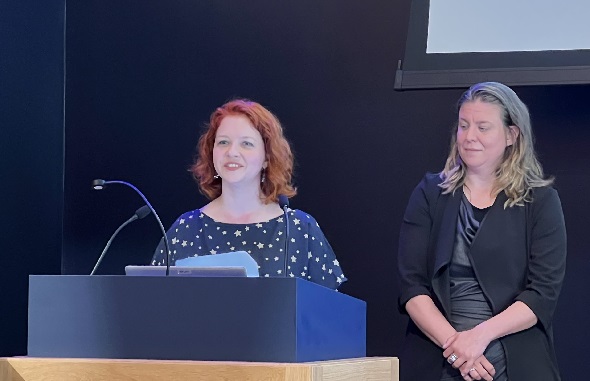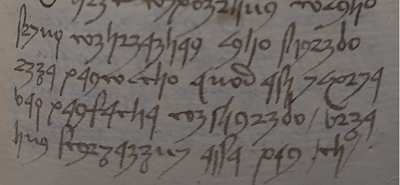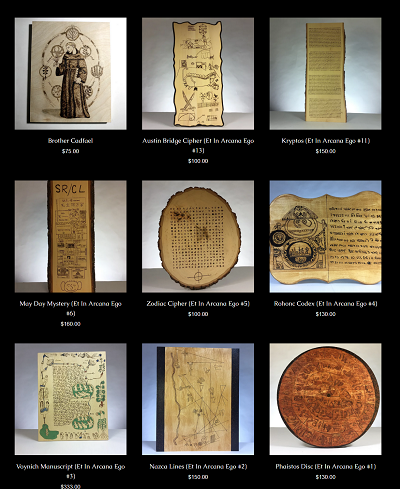Bei der HistoCrypt gab es einen Vortrag über das verschlüsselte Buch “The Subtlety of Witches”. Die Referentinnen Kat Mueller und Rian Hagebeuk konnten so manches Rätsel um dieses Werk lösen. Dennoch gibt es noch offene Fragen.
English version (translated with DeepL)
Welche verschlüsselten Bücher gibt es außer dem Voynich-Manuskript? Da ich mir diese Frage vor ein paar Jahren stellte, setzte ich eine Liste auf, die inzwischen als “Encrypted Book List” abrufbar ist.
The Subtlety of Witches
Mit der Nummer 00010 findet man auf dieser Liste das Buch “The Subtlety of Witches”, das (angeblich) aus dem Jahr 1657 stammt und von einem Ben Ezra Aseph verfasst wurde. Tony Gaffney hat dieses Werk in der British Library ausfindig gemacht. Über Nick Pellings Webseite bin ich darauf aufmerksam geworden.
“The Subtlety of Witches” hat etwa 400 Seiten, die allesamt verschlüsselt sind. Hier ist ein Auszug: Im Gegensatz zum Voynich-Manuskript enthält “The Subtlety of Witches” keine Bilder. Die verwendete Verschlüsselung ist eine einfache Buchstaben-Ersetzung, die Tony Gaffney ohne größere Mühe lösen konnte. Hier ist der Schlüssel:
Eine Forschungsarbeit zum Buch
Über meine “Encrypted Book List” wurde die Hobby-Historikerin Kat Mueller aus Portland (US-Bundesstaat Oregon) auf “The Subtlety of Witches” aufmerksam. Kat ist übrigens auch als Künstlerin aktiv. Einige der folgenden Motive dürften Cipherbrain-Lesern durchaus bekannt vorkommen:
Kat beschloss, sich näher mit “The Subtlety of Witches” zu beschäftigen. Über Reddit fand sie eine Partnerin: Rian Hagebeuk aus den Niederlanden. Bei der HistoCrypt 2022, die von Montag bis Mittwoch dieser Woche in Amsterdam stattfand, traf ich die beiden (links Mueller, rechts Hagebeuk):
Was Kat und Rian herausfanden, kann man in ihrer Arbeit nachlesen, die im HistoCrypt-Konferenzband veröffentlicht worden ist. Interessant ist zunächst einmal, dass das Buch höchstwahrscheinlich nicht 1657 verfasst wurde, sondern etwa 100 Jahre früher.
Kat und Rian machten sich die Arbeit, das gesamte Buch zu entschlüsseln. Schnell zeigte sich, dass der Inhalt nichts mit Hexen zu tun hat, auch wenn der Titel dies nahelegt. Stattdessen kam beim Entschlüsseln ein in Latein und Niederländisch geschriebenes Wörterbuch zum Vorschein, das im Stil des Italieners Ambrogio Calepino (1440-1509 oder 1510) verfasst war. Calepino gilt als Pionier des Wörterbuch-Wesens, wodurch “Calepino” in mehreren Sprachen zur Bezeichnung für ein Wörterbuch schlechthin geworden ist. Calepino-Wörterbücher waren zur vermuteten Entstehungszeit des Buchs weit verbreitetet.
Offene Fragen
Die Titelseite von “The Subtlety of Witches” enthält anscheinend nur falsche Angaben. Der Titel passt nicht zum Inhalt, die Jahreszahl ist falsch, und der Name des Autors dürfte ebenfalls nicht stimmen. Vermutlich wurde die Titelseite nicht vom Autor selbst erstellt, sondern ist ein späterer Zusatz. Ob der Urheber dieser zusätzlichen Zeilen absichtlich oder versehentlich falsche Angaben machte, ist unklar.
Unklar ist auch, wer das Buch verfasst hat. Laut Kat und Rian muss es eine Person aus dem protestantischen Umfeld gewesen sein. Genaueres ist nicht bekannt. Die beiden sind jedoch noch dabei, dies zu erforschen.
Rätselhaft ist außerdem, warum damals jemand ein Wörterbuch verschlüsselt hat, dessen Inhalt nichts Geheimes an sich hatte. Hat vielleicht ein Leser eine Idee?
Und schließlich gibt es auf der Titelseite noch ein paar verschlüsselte Wörter, deren Dechiffrierung noch nicht geglückt ist:
Kann ein Leser etwas dazu sagen? Kat und Rian würden sich sicherlich über Hinweise freuen.Follow @KlausSchmeh
Further reading: HistoCrypt 2019: A video and a few more photos
Linkedin: https://www.linkedin.com/groups/13501820
Facebook: https://www.facebook.com/groups/763282653806483/









Kommentare (11)